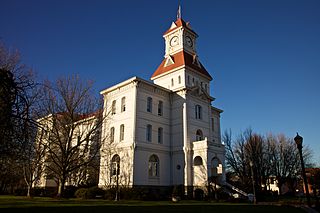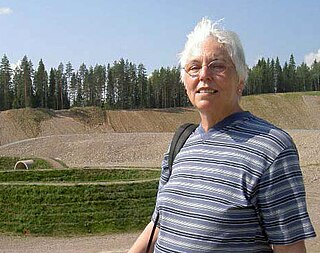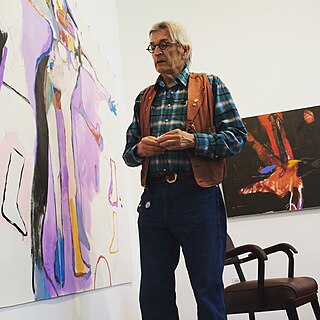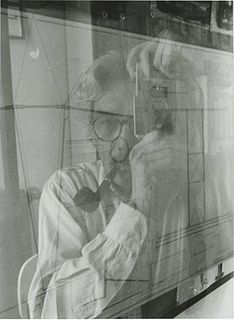Related Research Articles

Corvallis is a city in central western Oregon, United States. It is the county seat of Benton County and the principal city of the Corvallis, Oregon Metropolitan Statistical Area, which encompasses all of Benton County. As of the 2010 United States Census, the population was 54,462. Its population was estimated by the Portland Research Center to be 58,641 in 2018. Corvallis is the location of Oregon State University and Good Samaritan Regional Medical Center.

Land art, variously known as Earth art, environmental art, and Earthworks, is an art movement that emerged in the 1960s and 1970s, largely associated with Great Britain and the United States, but which included examples from many countries. As a trend "Land art" expanded boundaries of art by the materials used and the siting of the works. The materials used were often the materials of the Earth including for instance the soil and rocks and vegetation and water found on-site, and the siting of the works were often distant from population centers. Though sometimes fairly inaccessible, photo documentation was commonly brought back to the urban art gallery.
Environmental design is the process of addressing surrounding environmental parameters when devising plans, programs, policies, buildings, or products. It seeks to create spaces that will enhance the natural, social, cultural and physical environment of particular areas. Classical prudent design may have always considered environmental factors; however, the environmental movement beginning in the 1940s has made the concept more explicit.

Sir William Blake Richmond KCB, RA, PPRBSA was an English portrait painter, sculptor and a designer of stained glass and mosaic. He is best known for his portrait work and decorative mosaics in St Paul's Cathedral in London.
Alice Aycock is an American sculptor and installation artist. She was an early artist in the land art movement in the 1970s, and has created many large-scale metal sculptures around the world. Aycock's drawings and sculptures of architectural and mechanical fantasies combine logic and imagination, and intermingle science and faith.

Light tubes are physical structures used for transmitting or distributing natural or artificial light for the purpose of illumination, and are examples of optical waveguides.

Otto Piene was a German-American artist specializing in kinetic and technology-based art, often working collaboratively. He lived and worked in Düsseldorf, Germany; Cambridge, Massachusetts; and Groton, Massachusetts.

Nancy Holt was an American artist most known for her public sculpture, installation art and land art. Throughout her career, Holt also produced works in other media, including film and photography, and wrote books and articles about art.

Oregon Pioneer, also known as Gold Man, is an eight-and-a-half ton bronze sculpture with gold leaf finish that sits atop the Oregon State Capitol in Salem, Oregon, United States. Created by Ulric Ellerhusen, the statue is a 22 ft (7 m)-tall hollow sculpture. The gilded piece was installed atop the building in 1938 when a new capitol was built.

The Lillis Business Complex (LCB) is a building on the University of Oregon campus in Eugene, Oregon. It is home to the Charles H. Lundquist College of Business ,. The Complex consists of four buildings; the new main building, completed in 2003, and three older buildings, Anstett Hall, Peterson Hall, and the Chiles Business Center.

Environment Oregon is a political non-profit organization in the U.S. state of Oregon, that lobbies for legislation in regard to environmental policy on local, state and national levels. It is affiliated with Environment America, a federation of environmental organizations in thirty states. Based in Portland, Oregon, it has more than 35,000 members throughout the state. It is also partnered with the Environment Oregon Research & Policy Center, its sister 501(c)(3) organization.

Richard Elmer "Rick" Bartow was a Native American artist and a member of the Mad River Band of Wiyot Indians, a small tribe indigenous to Humboldt County, California. He primarily created pastel, graphite, and mixed media drawings, wood sculpture, acrylic paintings, drypoint etchings, monotypes, and a small number of ceramic works.
Agnes Denes is a Hungarian-born American conceptual artist based in New York. She is known for works in a wide range of media - from poetry and philosophy writings, to complex hand and computer rendered diagrams, sculpture, and international environmental installations, such as Wheatfield -- A Confrontation (1982), a two-acre wheatfield in downtown Manhattan.
Charles Ross is an American sculptor and earthwork artist. In 2011, he was named a Guggenheim Fellow.

Weather Machine is a lumino kinetic bronze sculpture and columnar machine that serves as a weather beacon, displaying a weather prediction each day at noon. Designed and constructed by Omen Design Group Inc., the approximately 30-foot-tall (9 m) sculpture was installed in 1988 in a corner of Pioneer Courthouse Square in Portland, Oregon, United States. Two thousand people attended its dedication, which was broadcast live nationally from the square by Today weatherman Willard Scott. The machine cost $60,000.

Francesco Gostoli is an Italian architect. He has written a great number of articles and studies for journals and magazines. He invented the Metro Armonico, a means of creating and defining ergonomic dimensions, published in “Architecture as I see it”, 2004.
Rockne Krebs was a contemporary American artist and sculptor.

Nepenthes is a series of four sculptures by artist Dan Corson, installed in 2013 along Northwest Davis Street in the Old Town Chinatown neighborhood of Portland, Oregon, in the United States. The work was inspired by the genus of carnivorous plants of the same name, known as tropical pitcher plants. The sculptures are 17 feet (5.2 m) tall and glow in the dark due to photovoltaics.
Da Vinci Days is an annual festival held in Corvallis in the U.S. state of Oregon. The science, technology, and art based festival includes live music, a kinetic sculpture race during the summer event, and lecture series in the spring. The festival is named after Italian inventor, artist, and writer, Leonardo da Vinci.
Dan Corson is an artist living in Hawaii and is a former member of the Seattle Arts Commission. He works in the field of public art, creating large-scale, concept-driven works installed in urban environments including in parks, railway stations, art galleries, meditation chambers, at intersections, under freeways, and on sidewalks. His approach is a mixture of sculpture, installation, theatrical design, architecture, and landscape design. Media include metal, glass, concrete, fiberglass, gravel, LEDs, lasers, neon, solar panels, radar detectors, photo-voltaic cells, infra-red cameras, motors, searchlights, and occasionally elements such as fire, water, and smoke. His work frequently incorporates cutting-edge technology in lighting, sound, and other electronic media.
References
- 1 2 3 Gail Cole (October 17, 2011). "Solar art comes to light". Corvallis Gazette-Times . Retrieved 2014-02-06.
- 1 2 3 Susan Landauer, ed. (2006), Art of Engagement: Visual Politics in California and Beyond, University of California Press, pp. 245–246, ISBN 0520240537
- 1 2 3 4 John R. Clarke (September 2001). "Seeing Rainbows Among the Ruins: Peter Erskine's 'New Light on Rome'". Sculpture Magazine . Retrieved 2014-02-06.